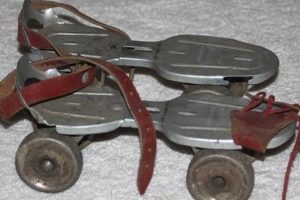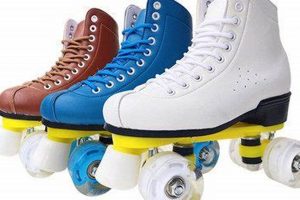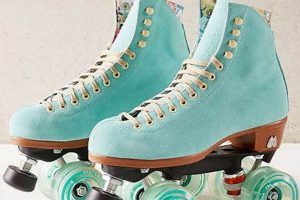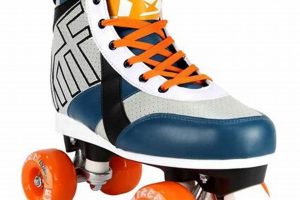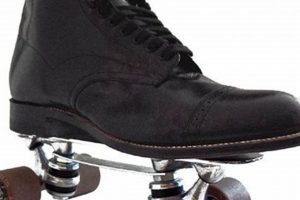The equipment utilized for recreational or competitive rolling activities comes in several distinct configurations. These variations cater to different skill levels, intended usage scenarios, and personal preferences, significantly impacting the overall skating experience. For instance, some designs are optimized for speed and agility on smooth surfaces, while others prioritize stability and maneuverability for more varied terrains.
Understanding the various forms available is essential for both novice and experienced individuals. This knowledge ensures the selection of equipment best suited to one’s specific needs and aspirations. Moreover, it allows for informed decisions that can enhance performance, safety, and enjoyment, ultimately leading to a more fulfilling engagement with the sport.
This article will explore the common configurations, examining their characteristics, advantages, and typical applications. A detailed overview will equip readers with the necessary information to make informed choices when selecting appropriate equipment for their skating pursuits.
Equipment Selection Guidance
Proper selection greatly influences performance and safety. Awareness of key features and intended use-cases is crucial for optimal experience.
Tip 1: Consider Skill Level: Beginners should prioritize stability. Quad configurations or inline designs with shorter wheelbases offer enhanced balance and control for initial learning.
Tip 2: Define Intended Use: Recreational skating necessitates comfortable and durable equipment. Aggressive skating requires robust designs with reinforced components to withstand impact.
Tip 3: Evaluate Wheel Hardness: Softer wheels provide greater grip on slick surfaces. Harder wheels offer faster speeds on smooth, well-maintained pavements.
Tip 4: Assess Boot Comfort: Ill-fitting boots cause discomfort and impede performance. Ensure a snug, supportive fit with adequate ankle support to prevent injuries.
Tip 5: Examine Bearing Quality: Higher-rated bearings offer smoother, faster rolling performance. Regular maintenance and cleaning of bearings are vital for longevity.
Tip 6: Verify Brake System: Functional brakes are essential for safety. Inspect brake pads for wear and replace them as needed to maintain optimal stopping power.
Tip 7: Research Brand Reputation: Established brands often provide higher quality materials and construction. Reading reviews and comparing features aids in identifying reputable manufacturers.
Careful attention to these elements allows for informed decisions, increasing enjoyment and minimizing risks. Selecting appropriately enables skaters to maximize potential within their chosen discipline.
This guidance provides a foundation for making discerning choices regarding skating equipment. The next section will delve into specific product recommendations based on individual preferences and anticipated usage scenarios.
1. Quad (traditional)
Quad configurations represent a foundational element within the broader category of equipment. Their design, characterized by two wheels at the front and two at the rear of the boot, offers inherent stability compared to inline alternatives. This attribute makes them a popular choice for beginners and those seeking a more controlled skating experience. The historical significance of quad designs also contributes to their prominent position; they were among the first commercially successful form, thereby shaping the early development and popularization of the activity.
The impact of quad designs extends beyond recreational use. They remain a preferred option in disciplines like roller derby and artistic skating, where maneuverability and controlled movements are paramount. In roller derby, the stability of the quad form allows for rapid changes in direction and body positioning, essential for effective gameplay. Similarly, artistic skaters utilize quad models to execute precise figures and routines, capitalizing on their inherent balance and control. The continued use in these specialized areas reinforces their ongoing relevance.
Understanding the function and advantages of quad configurations provides essential context for grasping the overall diversity of equipment available. Their emphasis on stability and controlled movement contrasts with the speed and agility-focused designs of other types. This distinction highlights the importance of aligning equipment choice with individual skill level, intended use, and desired skating style, ultimately contributing to a safer and more enjoyable experience.
2. Inline (rollerblades)
Inline configurations represent a significant divergence from traditional quad models, marking a key innovation within the broader category of skating equipment. Distinguished by their linear arrangement of wheels, these models prioritize speed and maneuverability, catering to a wide range of skating styles and skill levels. Understanding inline attributes is crucial for comprehending the diversity and specialization present within the overall spectrum of equipment options.
- Wheel Configuration and Speed
The in-line arrangement, with wheels aligned in a single row, minimizes rolling resistance, facilitating higher speeds compared to quad configurations. This design characteristic makes inline models particularly suitable for activities like speed skating, distance skating, and recreational fitness. Skaters benefit from increased efficiency and the ability to cover greater distances with less effort. Examples include long-distance skaters utilizing specialized inline models with larger wheels for enhanced speed and endurance, highlighting the direct correlation between wheel configuration and performance capabilities.
- Maneuverability and Agility
The narrow profile of inline configurations enables increased agility and maneuverability, making them well-suited for activities requiring quick turns and precise movements. This attribute is especially valuable in disciplines like slalom skating and urban skating, where navigating obstacles and executing complex maneuvers is essential. Inline designs allow skaters to navigate tight spaces and perform intricate footwork, showcasing the adaptability inherent in their construction. For example, urban skaters frequently employ inline models to navigate cityscapes, demonstrating the versatility of inline equipment in varied environments.
- Boot Design and Support
Inline models often feature higher boot designs offering increased ankle support, which is crucial for maintaining stability and preventing injuries during high-speed maneuvers or demanding skating activities. The supportive boot structure contributes to improved control and responsiveness, allowing skaters to execute complex movements with greater confidence. Recreational inline models typically feature padded liners for enhanced comfort, while performance-oriented models prioritize rigidity and responsiveness. This variation demonstrates the adaptability of boot designs to accommodate different skating styles and performance requirements.
- Braking Systems and Safety Features
Inline models typically incorporate heel brake systems for controlled deceleration, enhancing safety and providing skaters with a reliable stopping mechanism. The heel brake allows for intuitive braking, enabling skaters to quickly reduce speed or come to a complete stop in emergency situations. Some advanced inline models also feature adjustable brake systems, allowing skaters to customize the braking performance to their individual preferences and skill levels. This emphasis on safety features underscores the importance of responsible equipment design and its contribution to injury prevention.
The attributes of inline configurations, ranging from wheel arrangements to boot designs and braking systems, collectively contribute to their distinctive performance characteristics. These characteristics differentiate them from quad models and other forms of skating equipment, underscoring the need for informed selection based on individual skating goals and intended usage scenarios. A comprehensive understanding of these aspects enables skaters to make appropriate choices, maximizing both their enjoyment and safety within the diverse realm of skating activities.
3. Aggressive (street, park)
Aggressive models constitute a specialized segment within the diverse landscape of equipment, tailored for performance in demanding environments. Their design diverges significantly from recreational models, prioritizing durability and functionality to withstand the stresses of trick-based skating on urban and skate park terrains. Understanding their specific features is crucial for appreciating the specialized nature of equipment within the broader category.
- Reinforced Boot Construction
The boot is constructed from high-impact resistant materials, often including hardened plastics or composite materials. This reinforcement protects the skater’s foot from impacts during landings and collisions with obstacles. The robust construction extends the lifespan of the equipment under rigorous use. For instance, boots may incorporate additional padding and shock-absorbing liners to mitigate the force of impacts, reducing the risk of injury. The selection of materials and construction methods directly influences the boot’s durability and protective capabilities.
- Durable Frames and Grind Blocks
Aggressive models feature robust frames designed to withstand grinding on rails, ledges, and other surfaces. These frames are typically constructed from hardened aluminum or reinforced composite materials. The inclusion of grind blocks, replaceable components located between the wheels, facilitates sliding and grinding maneuvers. The design of the frame and grind blocks directly influences the skater’s ability to execute complex tricks and maneuvers. Examples include frames with recessed channels to improve lock-on during grinds and grind blocks with varying profiles to accommodate different skating styles.
- Small, Hard Wheels
Compared to recreational models, aggressive configurations utilize smaller, harder wheels to enhance control and durability during grinding and sliding. The reduced size of the wheels lowers the center of gravity, improving stability during tricks. The high durometer rating (hardness) of the wheels minimizes friction and maximizes speed on smooth surfaces. Examples include wheels with a diameter between 54mm and 60mm and a durometer rating of 88A or higher, optimized for park and street skating.
- Specialized Bearing Design
Bearings are designed to withstand the lateral forces and impacts associated with aggressive skating. These bearings often incorporate reinforced cages and high-quality lubricants to minimize friction and extend service life. The selection of appropriate bearings is critical for maintaining speed and performance under demanding conditions. Examples include bearings with ABEC ratings ranging from 5 to 7, indicating their precision and ability to withstand high loads.
The unique construction and specialized components of aggressive configurations distinguish them from other equipment options, reflecting the specific demands of trick-based skating. Their robust design and performance-oriented features contribute to the skater’s ability to execute complex maneuvers safely and effectively. The selection of appropriate equipment directly impacts performance and safety within this discipline.
4. Speed (racing)
Configurations designed for competitive speed encompass specialized features that distinguish them from general recreational or trick-oriented models. The pursuit of velocity necessitates design compromises that prioritize efficiency and aerodynamic performance. Consequently, specific attributes such as wheel size, frame composition, and boot construction are meticulously optimized to minimize resistance and maximize energy transfer. The selection of the appropriate configuration for speed represents a critical factor in competitive outcomes, directly influencing a skater’s ability to achieve peak performance. This influence stems from the direct correlation between equipment design and the capacity to generate and sustain high velocities over varying distances.
An examination of competitive speed events reveals the practical significance of these design considerations. For instance, marathon events often see athletes utilizing configurations with larger wheel diameters (110mm or 125mm) to reduce rolling resistance and maintain momentum over extended distances. Conversely, shorter sprint races may favor configurations with slightly smaller wheel diameters to enhance acceleration and maneuverability in tight racing conditions. The boot design, typically constructed from lightweight carbon fiber, provides a rigid platform for efficient power transfer from the skater’s leg muscles to the wheels, minimizing energy loss and maximizing propulsion. Furthermore, aerodynamic considerations influence boot height and overall profile, reducing drag and enhancing overall efficiency. These design choices, driven by the specific demands of competitive speed, underscore the direct link between equipment and performance.
In summary, the relationship between speed-oriented configurations and the pursuit of competitive racing is characterized by a deliberate optimization of design parameters. This optimization aims to minimize resistance, maximize energy transfer, and enhance aerodynamic efficiency. The selection of appropriate equipment represents a strategic decision, directly influencing a skater’s ability to achieve peak performance and compete effectively in speed disciplines. The ongoing refinement of equipment design, driven by technological advancements and the relentless pursuit of marginal gains, highlights the enduring importance of this relationship within the broader context of equipment.
5. Artistic (rhythmic)
Artistic configurations represent a highly specialized area, demanding precision, agility, and aesthetic expression. Unlike general recreational or speed-focused models, artistic designs prioritize maneuverability and control, enabling skaters to execute complex routines and figures. The design characteristics directly influence a skater’s ability to perform required skills.
- Boot Design and Ankle Support
Artistic boots are typically constructed from stiff leather or synthetic materials, providing exceptional ankle support and stability. The high-cut design allows for precise control over edges and movements. The rigidity of the boot facilitates intricate footwork and helps prevent ankle injuries. An example is the use of reinforced heel counters to enhance stability during spins and jumps. The boot’s design is pivotal for enabling advanced maneuvers.
- Plate and Truck System
The plate, connecting the boot to the wheels, is engineered for responsiveness and adjustability. The truck system, which houses the cushions or “kingpins,” allows skaters to fine-tune the responsiveness of the edges. Skilled adjustments of the truck system influence the ease with which a skater can execute turns and edge work. Different plate angles and truck tensions cater to individual preferences and skating styles. The configuration of the plate and truck system is crucial for achieving desired maneuverability.
- Wheel Characteristics
Artistic models employ wheels with specific characteristics optimized for gliding and grip. Wheel hardness, measured by durometer, affects the level of slip and control. Softer wheels provide greater grip for controlled edges, while harder wheels facilitate smoother gliding. The wheel profile, whether rounded or squared, also impacts maneuverability. Dancers often select wheel profiles that enable quick transitions between edges. Wheel selection is a critical aspect for performing various dance elements.
- Toe Stop Functionality
The toe stop, located at the front of the plate, serves as a braking mechanism and a tool for executing certain movements. Adjustable toe stops allow skaters to customize the height and angle, optimizing their functionality. Toe stops are used for jumps, spins, and pivots, requiring precise control and responsiveness. Different toe stop materials, such as rubber or plastic, affect the level of grip and slide. The proper adjustment and material of the toe stop are essential for executing a range of artistic skills.
These components are essential for executing the complex steps and graceful movements characteristic of artistic disciplines. Understanding the interplay between boot design, plate system, wheel characteristics, and toe stop functionality allows skaters to optimize their equipment for peak performance. Choosing the correct equipment enhances their ability to express artistry on the rink.
6. Derby (roller derby)
Roller derby, a contact sport played on quad configurations, presents a unique intersection within the variety of skating equipment. Its specific demands for agility, stability, and impact resistance necessitate specialized equipment choices, influencing the evolution and adaptation of configurations used within the sport.
- Quad Configuration Dominance
Roller derby predominantly employs quad configurations due to their superior stability and maneuverability in close-quarters, high-contact situations. The quad design facilitates rapid lateral movements and quick stops, essential for gameplay. While inline options exist, the quad’s inherent stability offers a competitive advantage for most skaters. This dominance underscores the historical preference and practical benefits of quad designs within the roller derby context.
- Boot Construction and Protection
Boots used in roller derby prioritize ankle support and impact protection. Constructed from durable materials such as reinforced leather or synthetic composites, these boots withstand the physical demands of the sport. Additional padding and bracing minimize the risk of ankle injuries during collisions and falls. The robustness of the boot reflects the necessity for skater safety within the high-impact environment of roller derby. This aspect differentiates derby boots from those used in artistic or recreational skating.
- Wheel Selection and Surface Grip
Wheel selection is crucial in roller derby, emphasizing grip and controlled sliding. Wheel hardness, measured in durometer, varies depending on the skating surface and skater preference. Softer wheels provide greater grip on slick surfaces, while harder wheels offer increased speed on smoother tracks. The ability to maintain traction and control during gameplay is paramount, influencing wheel choices. Skaters often experiment with different wheel durometers to optimize performance on various track surfaces.
- Plate Design and Agility
The plate, connecting the boot to the wheels, influences a skater’s agility and responsiveness. Roller derby plates are typically constructed from lightweight yet durable materials, such as aluminum or composite alloys. Plate geometry impacts turning radius and overall maneuverability. A well-designed plate enhances a skater’s ability to navigate the track and execute strategic maneuvers. The design of the plate contributes significantly to the performance characteristics of derby equipment.
The specific requirements of roller derby have fostered the development of specialized equipment tailored for its unique demands. While the sport primarily utilizes quad configurations, the construction and features of boots, wheels, and plates reflect the need for enhanced protection, maneuverability, and control. These adaptations highlight the dynamic relationship between a specific sporting discipline and the evolution of associated equipment.
Frequently Asked Questions
This section addresses common inquiries regarding various roller skate configurations, offering concise and objective answers to enhance understanding and inform selection decisions.
Question 1: What are the primary differences between quad and inline skates?
Quad configurations feature two wheels at the front and two at the rear, offering enhanced stability, while inline designs position wheels in a single line, emphasizing speed and maneuverability.
Question 2: For beginners, which type of roller skate is recommended?
Quad configurations are generally recommended for beginners due to their inherent stability and ease of control, facilitating a smoother learning curve.
Question 3: What features distinguish aggressive roller skates from recreational models?
Aggressive models incorporate reinforced boots, durable frames, and smaller, harder wheels to withstand the stresses of trick-based skating on urban terrains, prioritizing durability and impact resistance.
Question 4: Are speed configurations suitable for recreational skating?
Speed configurations, designed for competitive racing, prioritize speed and efficiency. Their specialized design may not be optimal for general recreational use, where comfort and maneuverability are more important.
Question 5: What factors influence wheel selection for different roller skate configurations?
Wheel hardness, measured in durometer, and wheel size significantly impact performance. Softer wheels offer increased grip, while harder wheels provide greater speed. Wheel size influences rolling resistance and acceleration.
Question 6: How does boot design affect the performance of artistic roller skates?
Artistic boots feature a stiff construction and high-cut design to provide exceptional ankle support and control, facilitating precise movements and complex routines.
Understanding these distinctions allows for informed selection based on individual skill levels, intended use, and performance goals. The appropriate choice ensures a safer and more enjoyable experience.
The subsequent section will explore the maintenance and care of various roller skate configurations, providing guidelines for extending their lifespan and optimizing performance.
Types of Roller Skates
The preceding exploration has delineated the distinct attributes and applications associated with various configurations. From the stability-focused quad designs to the speed-oriented inline variants, and the specialized builds for aggressive, artistic, and derby disciplines, each serves a unique purpose. This overview underscores the importance of aligning equipment selection with individual skill level, intended skating style, and performance objectives.
The informed selection, maintenance, and appropriate use of “types of roller skates” contribute directly to both performance enhancement and safety. Continued technological advancements promise further refinements in design and materials, ensuring ongoing evolution and optimization within each skating discipline. Individuals are encouraged to leverage the knowledge gained to make discerning choices, maximizing both enjoyment and minimizing risks within the diverse world of rolling activities.


